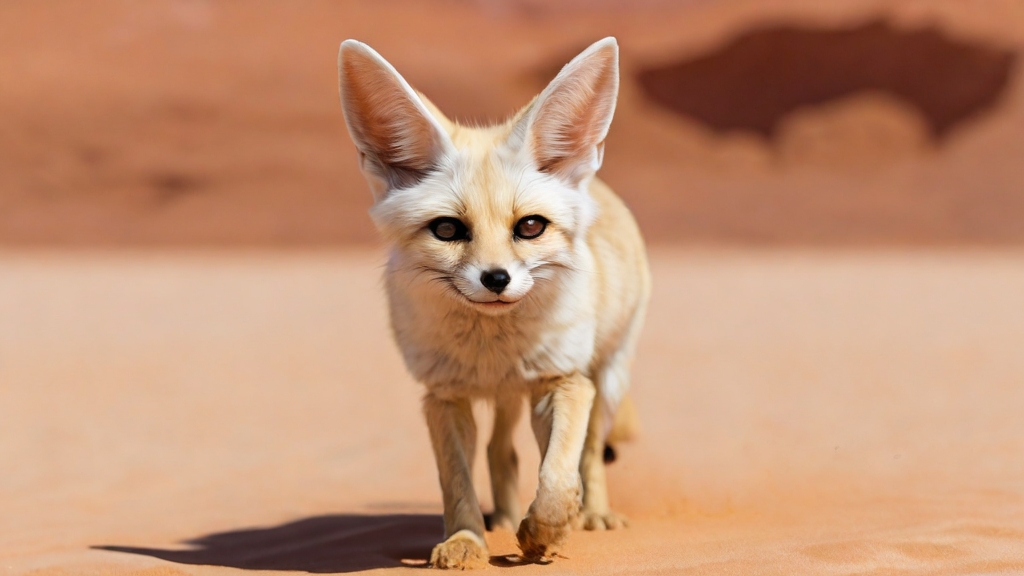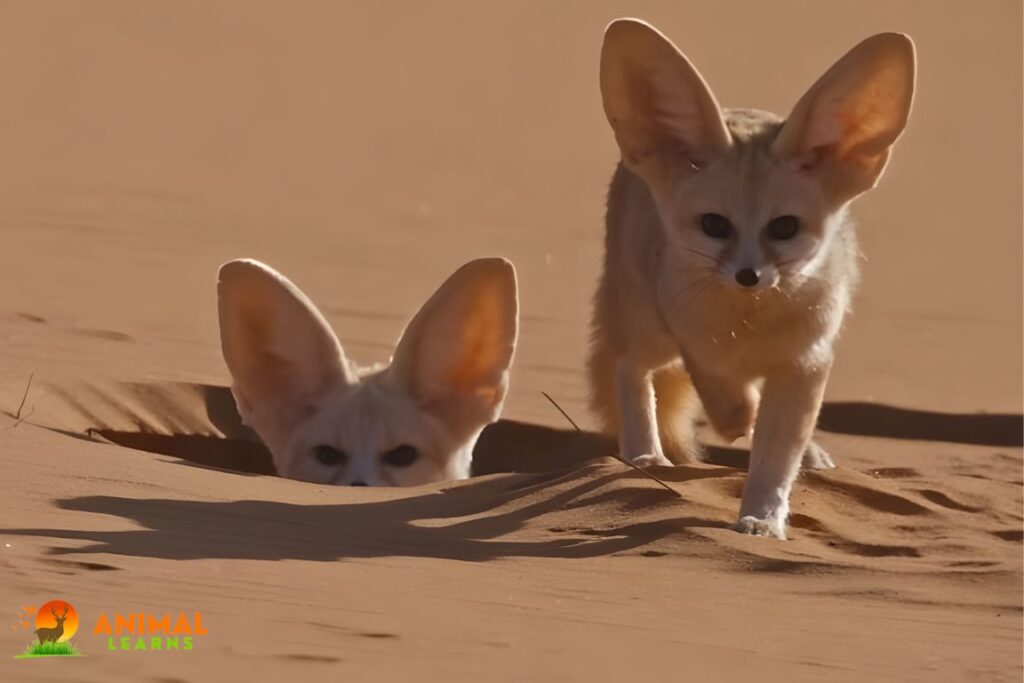Fennec Fox | Habitat, Diet, Population & Facts – Animallearns

Native to North Africa’s deserts, the fennec fox is not only the tiniest canine but also boasts the largest ears in proportion to its body size. These ears help them hear better and regulate their body temperature in the harsh settings they live in.
Due to their nocturnal lifestyle, fennec foxes are mainly protected from predators during the day and from the intense heat of Africa. Because of their cute look, they are maintained as pets both domestically and abroad in a large portion of their native habitat. Fennec foxes are referred to as vixens for females and reynards for males.
Appearance
Contents

The Fennec fox’s sand-colored fur keeps it warm at night by reflecting sunlight during the day. It has a black nose. The tip of its tapering tail is black. Its large ears are so thickly hairy inside that the external auditory meatus is hidden, and on the back are longitudinal reddish stripes.
The rear of the ears is darker than the white margins. The canid family has the largest ear-to-body ratio, which probably aids with heat dissipation and vertebrate location.
Its narrow nose is flanked by black stripes that extend from the inner eye. It has big, black eyes. Its thick fur covers the pads of its paws, making it easier to walk on hot, sandy terrain.
Distribution and Habitat
| Geography | |
| CONTINENTS | Africa |
| SUBCONTINENTS | Sub-Saharan Africa, North Africa |
| COUNTRIES | Morocco, Niger, Sudan, Tunisia, Western Sahara, Algeria, Chad, Egypt, Libya, Mali, Mauritania, |
| REGIONS | Sinai |
| BIOGEOGRAPHICAL REALMS | Palearctic, Afrotropical |
| WWF BIOMES | Desert and Xeric Shrublands |
The semi-arid and sandy desert parts of northern Africa, as well as the northern Sinai peninsula, are home to fennec foxes. Their range is somewhat broad, extending from Morocco to Egypt, from the south to the north to Niger and Sudan, and from the east to Kuwait.
The Sahara and Nubian deserts are home to fennec foxes, who excavate large subterranean tunnels. Dunes are believed to provide the best habitat for these animals.
Since wild fennec foxes can thrive in various desert environments, from coastal regions to more sparsely populated inland deserts, they are not currently considered to be too threatened in their natural environments, even though their precise distribution is unknown.
Behavior and Lifestyle

The majority of fennec foxes are nocturnal creatures that are most active at night. Their thick fur, which is sandy in color, makes it easier for them to blend in with the sand, but because of the intense heat during the day, they try to stay low.
Among all fox species, fennec foxes are the most gregarious (most other fox species are generally solitary and only get together for mating). In tiny colonies of up to ten people, they live in intricate, interconnected burrows, each individual or mating couple having its area inside their subterranean colony.
Similar to other dogs, male fennec foxes use urine to mark their territory and may get very hostile with one another, especially when they are vying for females during mating season.
Diet and Nutrition
Being omnivores, these creatures mostly consume fruits, roots, and leaves. Insects, rodents, eggs, and tiny reptiles can also be consumed by them. Since most of the water fennec foxes require comes from the plants and animals they eat, they may go for extended periods without drinking.
Mating Habits

| MATING BEHAVIOR | Monogamy |
| REPRODUCTION SEASON | January-February |
| PREGNANCY DURATION | 50 days |
| BABY CARRYING | 2-4 kits |
| INDEPENDENT AGE | 60-70 days |
| BABY NAME | kit, cub, pup |
Fennec foxes mate for life and are monogamous. Every year, females give birth just once during the breeding season, which spans from January to February.
A litter of two to four kittens is born between March and April after a gestation period of around fifty days. Weaning occurs after 60 to 70 days for kits. When they are old enough, they go hunting with their mother. It takes around ten months to attain reproductive maturity.
Fennec Fox Adaptations
The Night Life
North African deserts can get quite hot, and a little animal like a fennec fox might quickly get too hot to handle when it’s out in the middle of the day. These cute guys are nocturnal because of this.
After spending the day sleeping soundly in their cozy, cool burrow, they head out hunting at dusk. They remain warm on chilly evenings in the desert because of their thick fur.
Big Ears
The large, fluffy ears of a fennec fox are its most characteristic trait. They have a maximum length of 6 inches. That is almost 25% of their entire body length. They can hear bugs and rodents underneath for their meal because of their enormous ears.
In addition, they give the fox a significant increase in body surface area, which helps it stay cool on scorching desert days by dissipating body heat.
Thick, Sandy Fur
When fennec foxes must venture outside during the day, their thick, sand-colored fur helps reflect sunlight and keep them cool. Their toes are shielded from the scorching sand by fur that reaches the soles of their feet.
They can run more freely on loose sand and dig their burrows more swiftly because of the increased traction provided by the hair on their soles.
Population

Population threats
There aren’t any significant dangers to fennecs worldwide at the moment. New settlements and road building raise the risk and disruption for certain people. While people in the Sinai and Sahara kill these foxes for their fur or to sell to tourists, they pose no harm to any human interest, including cattle.
Total Population
Although the exact number of Fennec foxes in existence is unknown, it is believed to be sufficient because traffickers in Northern Africa sometimes catch them for tourist attractions or displays. The Fennec fox is categorized by the ICUN as “Least Concern” because of its steady population trend.
Fennec Fox Facts

- This fox’s name is derived from the Arabic name for the species, fanak (فَنَك).
- Alopecia, or “love handles,” is a characteristic of vixens that appear during the breeding season.
- Fennecs are cold-blooded creatures that tremble in temperatures below 68 degrees Fahrenheit.
- They have a scent gland on the tip of their tail that allows them to release a musky odor when frightened.
- Algeria’s national animal is the Fennec fox. Les Fennecs, the national football team of Algeria, also goes by this moniker.
Connection with Humans
The fennec fox is a widely distributed species that only truly interacts with humans in specific areas because it can thrive in the most inhospitable and isolated parts of the desert.
As local human populations grow, fennec foxes are beginning to face a growing danger from habitat degradation as human settlements increase.
Locals have traditionally hunted fennec foxes for their gorgeous fur, and they are frequently caught and sold into the exotic pet trade worldwide.
Fennec Fox Pictures Collection for Wallpapers



FAQs
Can a fennec fox be a pet?
No. Since they are wild creatures, fennec foxes need more specialized care than most pet owners can offer. Owing to its unique requirements and untamed nature, owning one may be prohibited in many places.
How does a fennec fox cost?
The price of a fennec fox can be high, usually between $1,500 and $3,500 for the animal itself.
Are fennec foxes aggressive?
They can be shy or guarded among strangers, but they are not naturally hostile. It is essential to socialize and handle people properly. If they are not handled with care, their untamed impulses may result in uninvited biting or scratching.
Are Fennec Foxes herbivores, carnivores, or omnivores?
Being omnivores, fennec foxes consume both animals and plants.
What class do Fennec Foxes belong to?
Fennec Foxes belong to the class Mammalia.












